Demography and Population Growth Models
1/65
There's no tags or description
Looks like no tags are added yet.
Name | Mastery | Learn | Test | Matching | Spaced |
|---|
No study sessions yet.
66 Terms
What is the shape of the curve representing exponential population growth?
J-shaped.

What is the formula to calculate the change in population size over time?
The change in population size (ΔN/Δt) = rN.

What do the variables b, d, and r represent in the context of population growth?
b = birth rate, d = death rate, r = rate of change of the population.
Under what conditions can a population grow exponentially?
As long as the rate of change (r) is positive.
What does lambda (λ) represent in population projections?
Lambda (λ) is the finite multiplication rate of the population.
How can the future population size be projected using lambda?
Using the equation N(t) = N(0)λ^t.
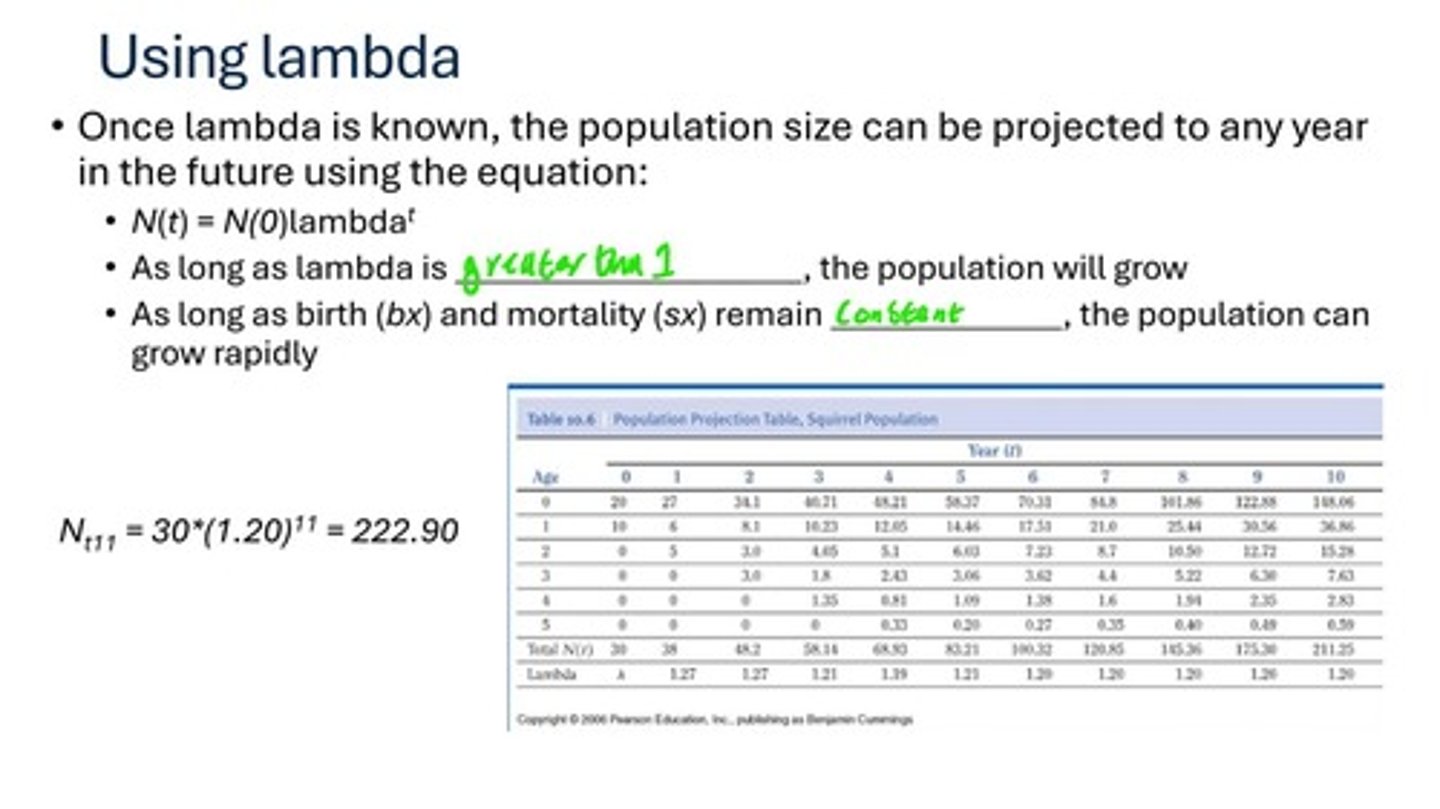
What condition must lambda meet for the population to grow?
Lambda must be greater than 1.
What are age-specific birth rates (b) and survival rates (s) used for in population studies?
They represent the expected reproductive output and the proportion of individuals that survive to the next age class, respectively.
How is the finite multiplication rate (lambda) calculated?
Lambda = N(t+1)/N(t).
What was the constant rate of increase for the squirrel population after year 5?
Approximately 20% per year.
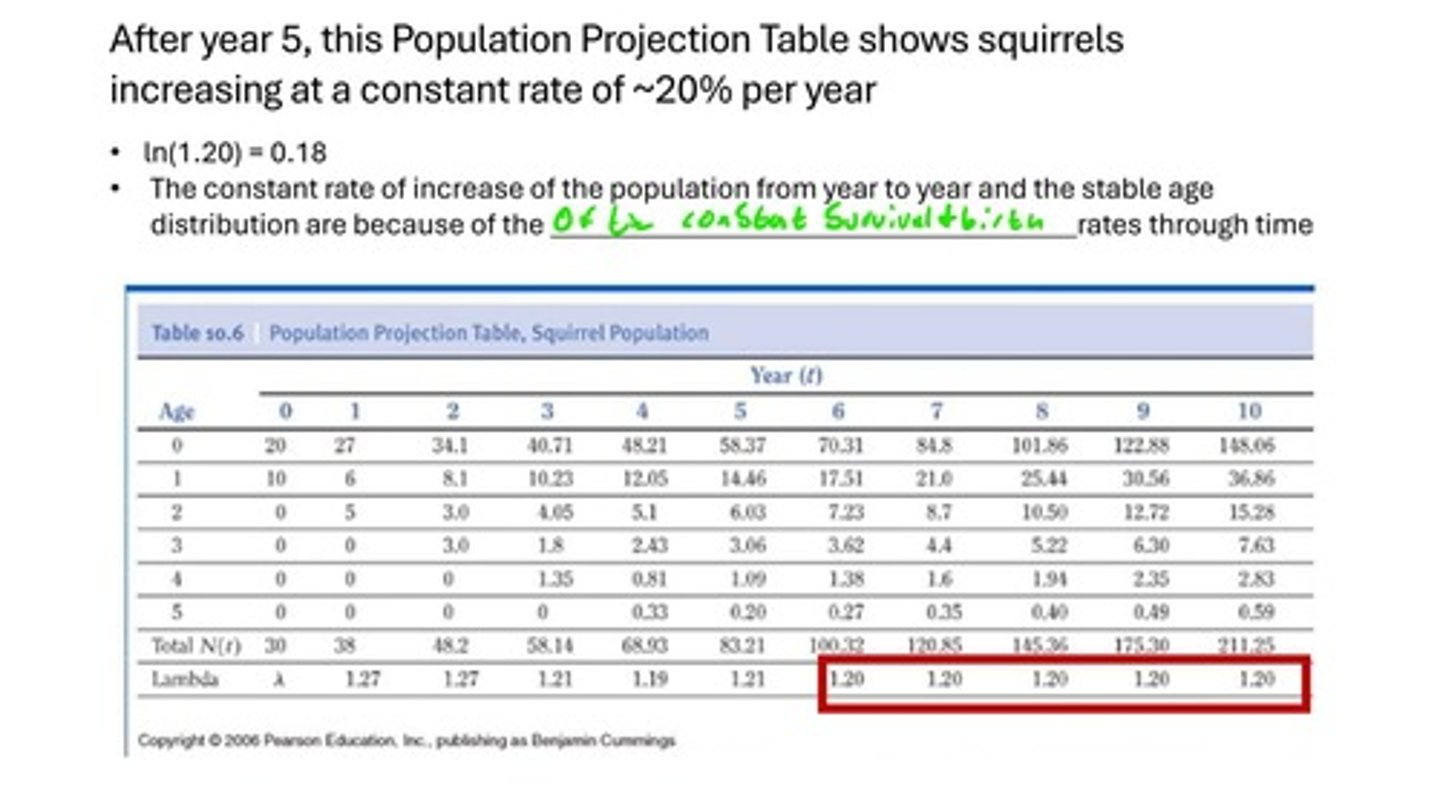
What does a stable age distribution indicate in a population?
It indicates constant survival and birth rates through time.
What is the significance of the population projection table for the squirrel population?
It shows the population size and growth rate over time based on age-specific survival and birth rates.
What does a lambda value of 1.27 indicate about the population?
It indicates that the population is increasing by 27% from one time period to the next.
What is the relationship between birth rates (bx) and mortality rates (sx) in population growth?
They are used to calculate lambda and determine population growth.
What does a population growth model assume about environmental conditions?
It assumes ideal environmental conditions for maximum growth.
What is the change in population size represented by ΔN?
ΔN is the change in the number of individuals in the population.
What is the significance of the year intervals in the population projection table?
They indicate the time periods over which population changes are measured.
How does the population size change if lambda is less than 1?
The population will decrease.
What does the term 'constant rate of increase' imply about the population dynamics?
It implies that the population is growing at a steady rate year after year.
What factors can affect the values of birth rates and survival rates in a population?
Environmental conditions, resource availability, and competition.
What does the term 'exponential growth' mean in the context of population dynamics?
It refers to a situation where the population size increases at a rate proportional to its current size.
What is the role of the Colorado River in shaping the Grand Canyon?
It carved the canyon over millions of years through erosion.
What is the purpose of a population projection table?
To summarize the reproductive output of females and project future population sizes based on survivorship and age-specific birth rates.
What does the population size N(t) depend on?
The survivorship (sx) of females in each age class and the product of the age-specific birth rates (bx) of females.
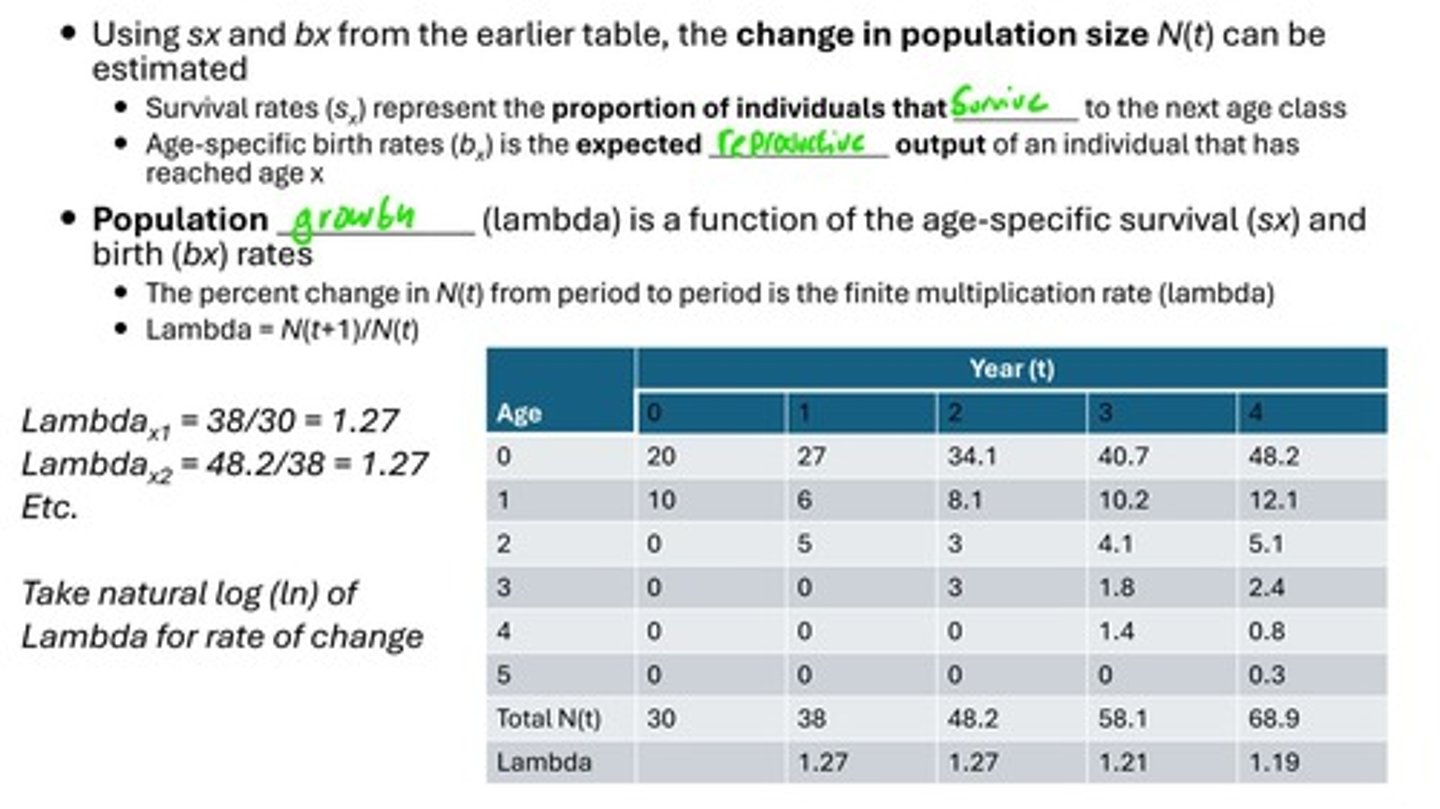
What is a reproductive table?
An age-specific summary of the reproductive rates of females in a population, recording the number of female offspring produced by each age group.

At what age range is reproduction greatest for Belding Ground Squirrels?
Between the ages of 4-5 years.
What is the average number of female offspring produced by Belding Ground Squirrels at age 4-5?
2.59 female offspring.
How is the average number of female offspring calculated?
By multiplying the proportion of females weaning a litter by the mean number of females in a litter.
What does the term 'survivorship' (sx) represent?
The proportion of individuals that survive to the next age class.

How is the survivorship (sx) calculated?
sx = 1 - qx, where qx is the age-specific mortality rate.
What is the significance of fecundity tables?
They take into account age-specific birth rates (bx) and survivorship (lx) to estimate reproductive output.
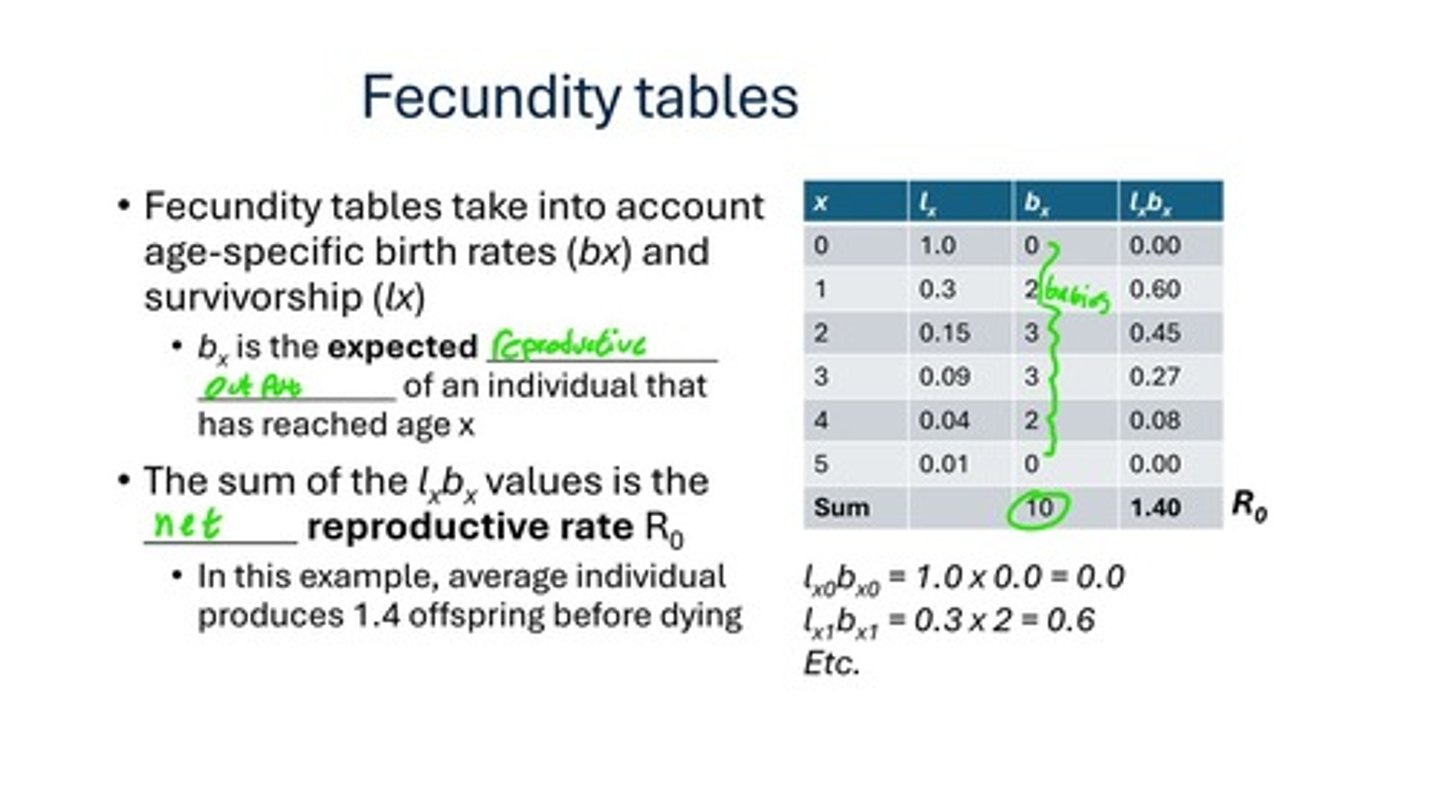
What does the net reproductive rate (Ro) represent?
The average number of offspring produced by an individual before dying.
How is the net reproductive rate (Ro) calculated?
By summing the product of survivorship (lx) and age-specific birth rates (bx) for all age classes.
What is the crude reproductive rate?
It takes into account the number of offspring produced per some number of individuals in the population.
What is the more accurate way to determine birth rate in a population?
Estimating the number of births of female offspring per female who have reached reproductive age.
What is the average number of female offspring produced by Belding Ground Squirrels at age 2-3?
2.45 female offspring.
What does the mean size of litters indicate?
The average number of offspring (both males and females) produced by females in each age class.
What is the proportion of females weaning a litter at age 1-2?
0.65.
What does the term 'fecundity' refer to in population studies?
The reproductive capacity of an individual or population.
What is the significance of the age-specific mortality rate (qx)?
It helps in understanding the survival and reproductive potential of different age classes in a population.
What does the term 'age-specific birth rates' (bx) refer to?
The expected number of offspring produced by females of a specific age.
What is the average number of female offspring produced by Belding Ground Squirrels at age 6-7?
1.70 female offspring.
What is the average number of female offspring produced by Belding Ground Squirrels at age 8-9?
1.93 female offspring.
What is the average number of female offspring produced by Belding Ground Squirrels at age 9-10?
1.58 female offspring.
What is the significance of a plant species containing both male and female flower parts?
All individuals in the population can be counted for reproductive purposes.
What are the key learning objectives related to population studies?
Survivorship, Growth, Reproduction Rates, Population Projection.
How is life expectancy calculated?
It is calculated for newborn individuals (e0) and is affected by age-specific mortality rates throughout life.
What has contributed to the increase in human life expectancy?
Improvements in infant survival rates.
What do survivorship curves graph?
The number of individuals in a cohort still alive at each age.
Describe Type I survivorship curves.
Typically low survival at young ages, then high survival until old age when mortality increases rapidly, common in mammals.
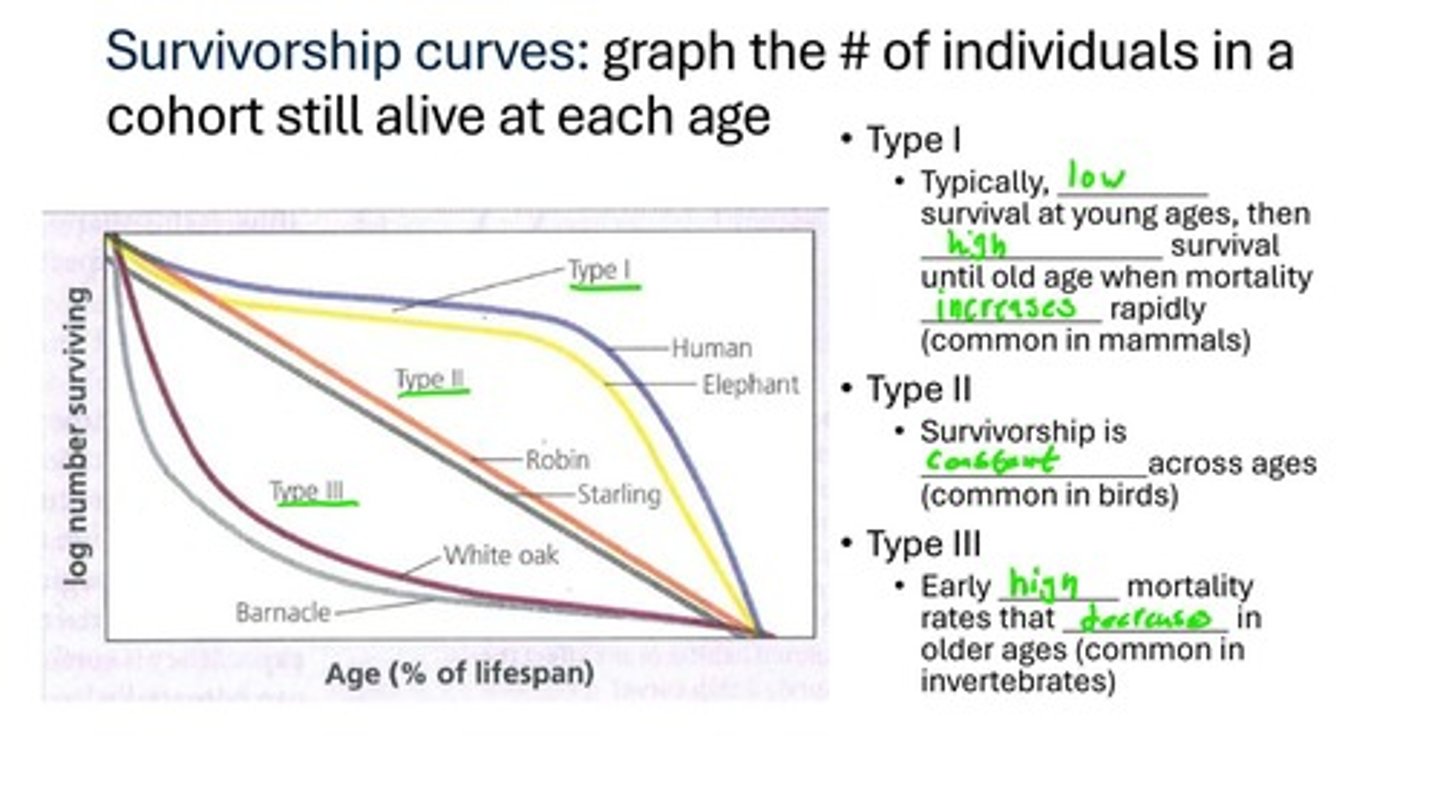
Describe Type II survivorship curves.
Survivorship is constant across ages, common in birds.
Describe Type III survivorship curves.
Early high mortality rates that decrease in older ages, common in invertebrates.
What is a life table?
An age-specific summary of the survival pattern of a population.
What does demography study?
Factors that affect population changes, including vital statistics such as birth, survivorship, reproduction, and death.
What is the average life expectancy for Belding Ground Squirrels at age 0-1?
0.61 years.
What is the death rate for male Belding Ground Squirrels at age 0-1?
0.65.
What does the term 'cohort' refer to in population studies?
Individuals of the same age followed throughout their lives.
What is the average life expectancy for female Belding Ground Squirrels at age 9-10?
1.00 years.
How does age-specific survivorship differ between males and females in polygynous mammals?
Males often experience higher age-specific mortality due to greater male-male competition.
What is the proportion alive at the start of year 1 for female Belding Ground Squirrels?
0.386.
What is the average life expectancy for male Belding Ground Squirrels at age 5-6?
0.50 years.
What does the term 'vital statistics' encompass in demography?
Birth, survivorship, reproduction, and death.
What is the death rate for female Belding Ground Squirrels at age 3-4?
0.68.
What does the term 'survivorship (lx)' refer to?
The number of individuals surviving to a given age.
What is the average life expectancy for male Belding Ground Squirrels at age 4-5?
0.68 years.
What is the significance of habitat quality in survivorship?
Differences in habitat quality may be reflected in survivorship curves.